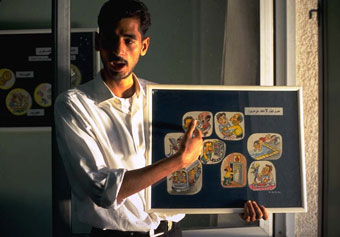 Photo credits : UNAIDS/K.Hesse
Photo credits : UNAIDS/K.HesseThere are literally thousands of AIDS-related programmes around the world. With such a wide variety of approaches and methodologies, sharing information about initiatives that have been successful is crucial to the ongoing development and improvement of AIDS programming.
To help drive the knowledge-sharing process, in 1997 UNAIDS began the production of its ‘Best Practice Collection’— a series of publications ranging from guidelines, updates and policy papers to case studies, handbooks, and examinations of particular challenges and responses, all designed to promote learning, share experience and empower people and partners engaged in the AIDS response.
“Knowing what works and what doesn’t, under what circumstances or cultural constraints, can help shape current and future programmes for AIDS,” said Alistair Craik, manager of the Collection. “The Best Practice Collection provides a wealth of ‘hands on’ experience that is useful and may be replicated.”
 Photo credits : UNAIDS/G.Pirozzi
Photo credits : UNAIDS/G.PirozziThe UNAIDS Collection provides examples of successful programmes from around the world which have been identified to inspire policy makers, programme managers and other stakeholders in their response to AIDS.
The Collection currently offers nearly 140 titles in English, 100 of which are also available in French, 75 in Spanish and 50 in Russian language editions. External evaluations conducted in 1999 and again in 2003 showed that the UNAIDS Best Practice Collection is a widely respected source of information for people working in the field of AIDS including non-governmental organizations, Ministries of Health and communities.
“The Collection includes some unconventional approaches such as collaborating with traditional healers in the AIDS repsonse.These examples of ‘best practice’ can help people to find new and effective ways to tackle the epidemic which they may not have been aware of before,” he added.
The UNAIDS Collection covers a wide range of topics from HIV workplace programmes to HIV prevention among injecting drug users and from programmes focusing on men who have sex with men to the faith-based response to AIDS.
 Photo credits : UNAIDS/O.O'Hanlon
Photo credits : UNAIDS/O.O'HanlonIdeas for new Best Practice publications come from various sources including people engaged in the response, local, national, and international policy and programme decision makers. UNAIDS also works in close collaboration with its ten cosponsoring UN organizations to further develop HIV-related information within their area of concern. UNAIDS has collaborated with UNHCR and ILO to produce two publications focusing on HIV programmes in refugee camps and in the workplace.
To be considered as a ‘best practice’ for the UNAIDS Collection, a programme must fulfill a number of fundamental criteria. First, the programme must be ethically sound. It must also be relevant, cost effective, sustainable and replicable. Best Practice publications are reviewed by experts within UNAIDS and from other UN system organizations.
“We distribute copies of new titles free of charge to people engaged in the AIDS response in low- and middle-income countries. Full text versions are also available on the UNAIDS website,” Craik said.
Over the next months, UNAIDS will be featuring a selection of programmes from the Best Practice Collection on the Web.
Links:
View Best Practice Collection





